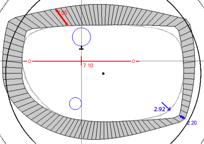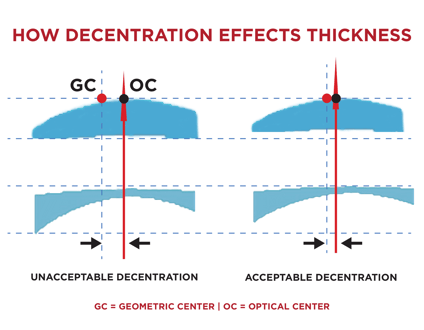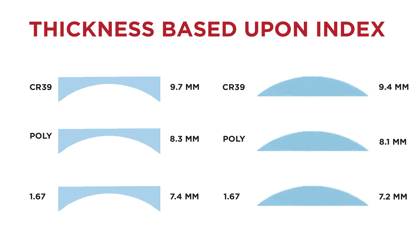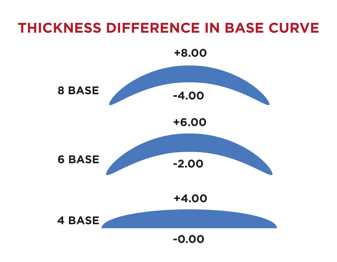Optics 101 Series Pt. 1 – Lens Thickness

Over the next year we will try to post a few articles geared towards those who are new in the industry or maybe those looking for a little refresher. We will simply title these our "Optics 101 Series".
To create a good pair of glasses that offer the best optics, fit, and comfort all start with the frame. Frame choice is the foundation that can either make or break the satisfaction for your patient.
The main goal of opticianry is recreating perfect 20/20 vision for your patient. The second goal should be doing this with the thinnest, lightest lenses possible. This will give your patient added comfort and good cosmetics. We are going to break this down into 5 parts of how to give your patient the best overall satisfaction, comfort, and performance of a pair of glasses.
Keeping these 5 key thoughts in mind will help you create the perfect pair of glasses for your patient. This will boost their overall satisfaction and help you win a customer for life.
Frame Size
 The larger the frame, the thicker the lenses! This is true for all prescriptions, but compounds itself in higher Rx jobs. Plus lenses will have thicker centers and minus lenses will have thicker edges. One of the most important things you can do to ensure patient satisfaction is to help guide your patient to a frame that not only looks good, but also works best with their Rx.
The larger the frame, the thicker the lenses! This is true for all prescriptions, but compounds itself in higher Rx jobs. Plus lenses will have thicker centers and minus lenses will have thicker edges. One of the most important things you can do to ensure patient satisfaction is to help guide your patient to a frame that not only looks good, but also works best with their Rx.
Setting realistic expectations can be the difference between a happy customer and a needless remake.
Frame Shape
Frame shape walk hand in hand with eyesize in determining the thickness of the lens. Soft, round shapes allow for thinner lenses than square or oblong shapes do.
for thinner lenses than square or oblong shapes do.
The key here is the ED (effective diameter) of the lens. The ED is simply defined as twice the longest radius of the lens blank. In simple terms, it is a measurement of the longest point from the geometric center of the lens times 2.
To find the center of a lens blank you start by tracing it on a piece of paper. Draw a box around the shape and then draw diagonals (an X) in the box. This will give you the center point of the blank.
Next, you measure from the center dot to the farthest point and then multiply times 2. This is the true ED.
What you will find is that a round shape with a 56 eye size will have a much smaller ED than an aviator shape in the same eye size. The few millimeters of difference will have an overall negative effect on lens thickness in the end.
Decentration
 Frame size alone is just part of the thickness equation. Decentration is the single biggest concern to keep in mind when it comes to whether a lens is as thin as it can be. Lens decentration occurs when the optical center of the lens is not in the geometric center of the eye of the frame.
Frame size alone is just part of the thickness equation. Decentration is the single biggest concern to keep in mind when it comes to whether a lens is as thin as it can be. Lens decentration occurs when the optical center of the lens is not in the geometric center of the eye of the frame.
Decentration of 2-3mm per eye is an acceptable amount, but anything over this in higher powers will create added thickness. Decentration is not based upon frame size alone. It is the difference between the patients PD and Frame PD (A measurement plus DBL).
A patient with a PD of 56 going into a 58/18 frame will have 20mm of total decentration or 10mm per eye. This will create a good amount of thickness to the nasal on plus Rxs and temple on minus Rxs.
This added thickness could be avoided by simply fitting your high power patients in frames that fit them properly. Remember, you are the professional; your patients have put their trust in you. Don’t be afraid to give them sound advice and help them with their frame choices.
Material (Index of Refraction)
 This is the place that most people start when wanting thin lenses. In most cases a 1.67 will be up to 25% thinner than a CR39. Let’s look at what a 10mm difference in frame PD will do.
This is the place that most people start when wanting thin lenses. In most cases a 1.67 will be up to 25% thinner than a CR39. Let’s look at what a 10mm difference in frame PD will do.
Here is an example of center thickness for a patient with a +6.00 Sph power with a 56 PD:
In a 58/18 frame – 20mm of decentration OU
CR39 will have a 13.1CT
1.67 will have an 8.2 CT
By utilizing a better fitting frame the CT will drop dramatically in both materials.
In a 48/18 frame – 10mm of decentration OU
CR39 will have a 6.6 CT
1.67 will have a 4.9 CT
While there is some serious thickness reduction in both examples from CR39 to 1.67, there is over a 50% reduction of thickness by just changing the eyesize by 10mm.
Base Curve
 Utilizing a flatter base curve will help improve overall thickness and reduce bulk in plus Rx lenses. The reduction by utilizing a 6 base over an 8 base in a +6.50 sph will be somewhere in the neighborhood of 6%.
Utilizing a flatter base curve will help improve overall thickness and reduce bulk in plus Rx lenses. The reduction by utilizing a 6 base over an 8 base in a +6.50 sph will be somewhere in the neighborhood of 6%.
While the overall thickness reduction of the lens blank is not substantial, but when combined with less bulk reducing the base curve will have a major effect on overall cosmetics.
On your high prescription patients, the combination of proper fit, utilizing high-index lens materials, and proper base curves will help you create the perfect pair of glasses for your patient.

